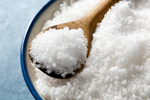 A new study has shown that our desire for salty foods can start really young. We can help curb the over-consumption of salt by helping our youngest members of society get a leg up.
A new study has shown that our desire for salty foods can start really young. We can help curb the over-consumption of salt by helping our youngest members of society get a leg up.
An interesting bit of health news found that six-month-old infants who have been introduced to starchy table foods — which often contain added salt — have a greater preference for salty taste than do infants not yet eating these foods. Reflecting their greater liking for salty taste, the exposed infants consumed 55% more salt during a preference test than infants who had not yet been introduced to starchy foods did.
At preschool age, the same infants were more likely to consume plain salt, demonstrating the enduring influence of such early exposure to salt. The findings highlight the potentially significant role of early dietary experience in shaping the salty taste preferences of infants and young children.
RECOMMENDED: Save Your Heart: Avoid These Hidden Sources of Salt
Estimates show that lowering salt intakes could prevent more than 100,000 deaths each year and save billions in medical costs in the U.S. alone. Starting back in 1969, officials have been calling for a reduction in sodium intake. While that message has been heeded to some degree, people still love salt. And will follow their urges for those foods.
In the study, the salt preference of 61 infants was tested at both two and six months of age. At each age, the infant was allowed to drink from three bottles for two minutes each. One bottle contained water, another contained a moderate concentration of salt (like that of chicken noodle soup), and the third had a higher concentration of salt (quite salty to adult tastes).
Two-month-old infants either were indifferent to (one percent) or rejected (two percent) the salt solutions. At six months, salty taste preference of the same infants was related to previous exposure to starchy table food. The 26 infants already eating starchy foods preferred both salt solutions to water, while the 35 babies who had not yet been introduced to these foods remained indifferent to or continued to reject the salt solutions.
Starchy foods they used were bread, crackers and cereals, which are often given to infants — and often contain added salt. Exposure to other types of table foods, such as fruit, was not associated with an increased preference for the taste of salt.
Too much salt puts a burden on many processes in the body, as well as having direct effects on the kidneys and heart.
